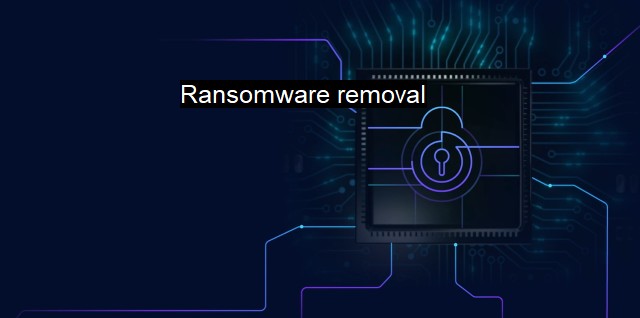What is Ransomware removal?
Ransomware Removal: Safeguarding Your Systems and Data against the Menace of Cyber Threats" - A Comprehensive Guide on Understanding and Preventing Ransomware Attacks in Today's Cyber Worl
Ransomware removal refers to the process of identifying, isolating, and eliminating malicious software known as ransomware from a compromised computer system or network. This process is crucial within the sphere of cybersecurity and often necessitates the use of sophisticated antivirus tools and techniques.Ransomware is a type of malicious software that, once it has infiltrated a target system, encrypts valuable data. The perpetrator then demands a ransom payment from the victim with the promise to provide the decryption key necessary to regain access to the encrypted files. Ransomware attacks can arise from multiple sources, such as emails with booby-trapped attachments, corrupted website links, and so on, posing significant risks to personal users, corporations, and even governments around the globe.
Where ransomware poses a severe threat, ransomware removal becomes monumental within the context of cybersecurity. The primary goal is to regain control of the infected system and restore it to its normal operational standards, without paying out the demanded ransom if possible. Allowing the attacker's demands bolsters the pervasive ransomware economy, encouraging cybercriminals to continue these malintent activities while leaving no guarantee that the victims will regain access to their files even after the payment.
The process of ransomware removal begins with the identification and differential analysis of the specific ransomware type impacting the system. Each variant of ransomware has unique behaviors and sequences. Knowing the exact ransomware type helps determine the most effective removal strategy and tools required.
Cybersecurity experts typically advise disconnecting the infected device from the network as fast as possible. This immediate response prevents the ransomware from spreading to other devices or systems within the network and limits overall damage.
Then comes the employment of various security tools such as antivirus and antimalware software. These tools possess system scans and other security features designed to help identify and eliminate ransomware from the infected systems. Depending on the ransomware type, some software can also decrypt the affected data. Cybersecurity professionals often analyze strains of ransomware in labs, and in some instances, are able to create decryption tools for certain types of ransomware, releasing them freely to the public.
For cases where decryption is impossible or not yet possible, another approach to ransomware removal involves restoring the affected system from trustworthy, uninfected backups predating the ransomware attack. This action may result in the loss of some data but could potentially save the majority of the accumulated data. Therefore, the importance of regular backups as part of a prudent cybersecurity strategy cannot be underestimated.
Ransomware removal ideally wraps up with a comprehensive system review to ensure the ransomware is no longer present in the system, and no residual vulnerabilities remain that could invite future attacks. Staying informed about the latest cybersecurity practices and maintaining up-to-date system patches, antivirus software, and well-trained users is key in preventing future ransomware attacks.
While ransomware removal can be a strenuous process, it is integral for any system user or organization since the impacts of an undiscovered attack are often disastrous. Ultimately prevention through sound cybersecurity measures is far superior to remediation. should the worst occur, understanding and being prepared for ransomware removal is paramount in mitigating the damage and quickly restoring a secure operational environment.

Ransomware removal FAQs
What is ransomware removal and why is it important?
Ransomware removal is the process of removing malicious software from a computer or network that has been infected by ransomware. Ransomware is a type of malware that encrypts files on a computer and demands payment in exchange for the decryption key. It is important to remove ransomware as soon as possible to prevent data loss and avoid paying the ransom.How can I remove ransomware from my computer?
The easiest way to remove ransomware from your computer is to use antivirus software. You can also try to decrypt your files using a decryption tool, or restore your files from a backup. However, it's important to note that sometimes ransomware can be so advanced that it's impossible to fully remove, so prevention is key.How can I prevent ransomware infections?
To prevent ransomware infections, you should always keep your antivirus software up to date and regularly scan your computer. It's also important to be vigilant when opening emails and clicking on links or attachments, as many ransomware attacks come from phishing scams. Additionally, it's a good idea to backup your important files regularly, so you can restore them without paying the ransom if necessary.What should I do if I've been a victim of a ransomware attack?
If you've been a victim of a ransomware attack, the first thing you should do is disconnect your computer from the internet and any other devices to prevent the malware from spreading. Then, contact a cybersecurity professional or your IT department for assistance in removing the ransomware and restoring your files. It's important not to pay the ransom, as there is no guarantee that you'll get your files back, and it only encourages the hackers to continue their illegal activities.| | A | | | B | | | C | | | D | | | E | | | F | | | G | | | H | | | I | | | J | | | K | | | L | | | M | |
| | N | | | O | | | P | | | Q | | | R | | | S | | | T | | | U | | | V | | | W | | | X | | | Y | | | Z | |
| | 1 | | | 2 | | | 3 | | | 4 | | | 7 | | | 8 | | |||||||